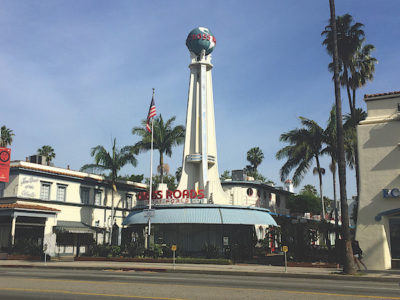McAvoy on Preservation: Crossroads of the World — is at a crossroad

A DENSE residential district and a hotel are being proposed at the historic Crossroads of the World. Laura Dominguez/L.A. Conservancy
“Negotiation.” “Compromise.” “Community benefit.” “Shared values.”
Words (and the attitudes and values they represent) matter. Historic preservation has always been a field in which these concepts have been employed. When precious real estate is at stake, and there is profit to be made, people in these conversations need to be mindful of what these words mean to them.
This has enormous immediacy for our area of Los Angeles while several development projects involving historic resources are making their ways through the planning process. The best time for discussion about what is important about a site is before there is an actual project on the table.
CBS Television City
Case in point: the successful resolution of the CBS Television City Historic Cultural Monument (HCM) discussion preceding action by the Cultural Heritage Commission. This was a case where the Los Angeles Conservancy and the owner held intensive conversations about character-defining features. Ultimately, both parties supported the designation.
Another approach is developer / community discussions about a project to determine what uses work for both. Developers of large projects seeking density bonuses and zone changes are required to provide information to the surrounding community and their government representatives through the California Environmental Quality Act (CEQA) process, a “full disclosure” process that analyzes the impacts of a specific project with developer-identified goals. The process allows the public to comment through written statements and hearings. Acceptance of the proposed project is up to government decision-makers (the Planning Department and City Council).

POSTCARD FROM 1937. Courtesy Los Angeles Conservancy archives
Crossroads of the World
Currently in the hearing stage is the aptly (and possibly ironically) named “Crossroads” project involving parcels in the Sunset / Las Palmas / Highland / Selma section of Hollywood.
The project, which has been somewhat modified already due to earlier community comment and the recent designation of the Hollywood Reporter Building as an HCM, proposes a dense residential district and hotel development. At present, its design approach will result in the demolition of several identified historic resources, including some Craftsman bungalows that are among the oldest in the community. It also will add new construction to the National Register-listed Crossroads of the World, and it also will demolish a cluster of 1930s courtyard apartments on Las Palmas Avenue and a 1920s two-story commercial building next to Crossroads. Historic properties in very close proximity are the Baptist Church on Selma Avenue and Blessed Sacrament Church on Sunset Boulevard.
New hotel
A hotel is proposed to be located across the street from the National Register-listed Hollywood High School. The Egyptian Theater and the Hollywood Boulevard Commercial and Entertainment District are a block to the north.
The project is in a transit-oriented development zone, where planners are encouraging more density on the theory that residents can take advantage of public transportation and alleviate traffic. There is a great need for affordable housing, and the project does provide some of that.
So, the discussion is complex. An analyzed alternative to the proposed project, which meets the requirements of the current Community Plan and saves the endangered buildings, has been declared financially unfeasible by a reputable consulting firm.
EIR comments
The majority of the written comments to the Draft Environmental Impact Report (EIR) were not supportive, although the project does have supporters. Over and over, in its responses to specific comments in the Final EIR, the applicant states that the CEQA analysis is sufficient but that the writers’ comments “will become part of the administrative record and will be considered by decision makers.” The comments were heard in front of planning staff members on May 15 in preparation for a future City Planning Commission meeting.
In addition, the Cultural Heritage Commission heard nominations for five remaining properties on May 17 and recommended to the City Council that four of them be approved as Historic-Cultural Monuments.
What’s next?
At the moment, we in the general public cannot know whether additional negotiation and compromise will result in more clarity about the community benefit of this project … or in a clear statement by the city of its oft-professed acknowledgement of historic preservation as a value for Los Angeles.
It is my personal opinion that more discussion is necessary to arrive at a solution which can “save the past and enrich the future,” to borrow a phrase from the National Trust for Historic Preservation. I truly believe there is an economically feasible, context-appropriate project with less severe impacts to historic resources here, and that there are good minds on the development team, in the community, and in the city who can craft such a project.
The EIR did disclose the issues, but it is not the end of the conversation. Let Councilmembers O’Farrell and Ryu, the Planning Commission, and the Office of Historic Resources know your thoughts.
By Christy McAvoy
Category: Real Estate


